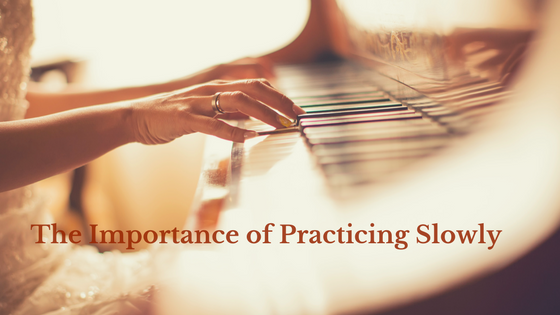When a student is working on a piece of music that is getting a bit sloppy – perhaps the tempo is uneven, the touch isn’t articulated or the notes aren’t clear – I often task him with SLOW PRACTICE. (Meaning that I am asking him to practice the piece veeerrry slowly.)
The student usually groans.
(Often times when the student returns to me the following week, I can tell that he didn’t actually practice the music slowly.)
But if the student DOES spend a week practicing the piece slowly then ohmygoodness, what a difference it makes. He returns to his lesson, plays the piece again at regular tempo, and we marvel at how much more polished, clear and beautiful the music sounds. He often observes how much easier it is to play and how he feels less frustrated!
So why does it work so well when a student actually implements slow practice?
Students often think I assign slow practice because it makes it easier for them to play a piece if they can play it slower. Of course it’s going to be easier, right?
But here’s the thing…it isn’t just practicing at a slow tempo that improves a piece. It’s actually being highly focused, mindful and connected to what you are practicing. You truly have to think through all the various elements of your music: the touch, dynamics, fingering, rhythm. Sometimes a student might even discover something he didn’t notice before (“Oh there’s a staccato in the LH that I wasn’t playing!”). He can also make sure he is being consistent with things like fingering and rhythm.
Students often are excited to get to the end result of learning a piece of music. Perhaps it’s because I played the piece for them and they are excited to play the fast and wild piece they heard. Perhaps it’s a familiar tune from the radio or a movie and they know what it’s “supposed to sound like.” But the process of learning — the how we get to that end result — is so important, too. When practicing slowly, students can figure out ways to more easily play a difficult passage. They can think about each and every detail and layer of a piece. They have a chance to break any bad habits so that when the tempo is increased, they use accurate and helpful technique. The brain can process the movements of the fingers, which means the brain and the muscles work together to enhance musical skills!
How and when should you implement slow practice?
When a student is working on transitioning a piece from practicing hands separately to hands together, slow practice is incredibly beneficial. Not only does it prevent frustration but it also helps with accurate rhythm, fingering and muscle memory.
If a student has been working on a piece for a long time — perhaps preparing for a recital or public performance, it can sometimes peak and then get sloppy. Slow practice helps the student to go back and think through each and every detail of the piece. They can “clean things up.”
Working on memorizing a piece? Slow practice is helpful for the brain to absorb all the information it will need to recall when the music is gone!
If your child is feeling particularly frustrated with a piece of music, encourage her to SLOW DOWN the tempo, wait until she is comfortable and confident in the passage at that tempo, and then work on increasing the speed of the music.
Try it! Practice a piece of music slowly for a few days — or have your student do the same. Notice any improvements?





4 thoughts on “Slow Practice: Why It’s Important”